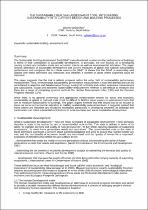 ResearchSpace
ResearchSpace
Sustainable building assessment tool: integrating sustainability into current design and building processes
JavaScript is disabled for your browser. Some features of this site may not work without it.
- ResearchSpace
- →
- Archives collection
- →
- Other Materials
- →
- View Item
| dc.contributor.author |
Gibberd, Jeremy T

|
|
| dc.date.accessioned | 2009-01-23T07:31:19Z | |
| dc.date.available | 2009-01-23T07:31:19Z | |
| dc.date.issued | 2008-09 | |
| dc.identifier.citation | Gibberd, JT. 2008. Sustainable building assessment tool: integrating sustainability into current design and building processes. World Sustainable Building Conference, Melbourne, Australia, 21-25 September 2008, pp 6 | en |
| dc.identifier.isbn | 978646503721 | |
| dc.identifier.uri | http://hdl.handle.net/10204/2882 | |
| dc.description | World Sustainable Building Conference, Melbourne, Australia, 21-25 September 2008 | en |
| dc.description.abstract | The Sustainable Building Assessment Tool (SBAT) was developed to ascertain the performance of buildings in terms of their contribution to sustainable development. In particular, the tool focuses on a developing country context and includes social and economic criteria as well as environmental indicators. The paper reviews definitions of sustainable development and current measures of global and national sustainability performance and compares this to criteria used in the SBAT. It shows that the SBAT is reasonable well aligned with these definitions and measures and identifies a number of areas where alignment could be improved. The paper suggests that the tool is reflects progress within the wider field of sustainability performance measurement. Here, environmental sustainability performance measurement is now well defined and can be ascertained in objective and detailed ways through ecological footprints and carbon emissions measurement and calculations. Social and economic sustainability measurement however is still difficult to measure and there are a range of competing systems such as the Human Development Index (HDI) and the Genuine Progress Indicator (GPI). While there is a general consensus and appropriate measurement system for social and economic sustainability at global or national scale it will be difficult to finalize these aspects in assessment tools that aim to measure sustainability in buildings. The paper argues however that this should not be an excuse to leave out social and economic indicators in building sustainability assessment tools. It suggests instead that these criteria are important and should be developed, particularly in developing countries, as buildings and construction can make substantial contributions to local economic and social sustainable development. | en |
| dc.language.iso | en | en |
| dc.subject | Sustainable building | en |
| dc.subject | Assessment tool | en |
| dc.title | Sustainable building assessment tool: integrating sustainability into current design and building processes | en |
| dc.type | Other Material | en |
| dc.identifier.apacitation | Gibberd, J. T. 2008. <i>Sustainable building assessment tool: integrating sustainability into current design and building processes.</i> http://hdl.handle.net/10204/2882 | en_ZA |
| dc.identifier.chicagocitation | Gibberd, Jeremy T. 2008. <i>Sustainable building assessment tool: integrating sustainability into current design and building processes.</i> http://hdl.handle.net/10204/2882 | en_ZA |
| dc.identifier.vancouvercitation | Gibberd JT. 2008. <i>Sustainable building assessment tool: integrating sustainability into current design and building processes.</i> http://hdl.handle.net/10204/2882 | en_ZA |
| dc.identifier.ris | TY - Other Material AU - Gibberd, Jeremy T AB - The Sustainable Building Assessment Tool (SBAT) was developed to ascertain the performance of buildings in terms of their contribution to sustainable development. In particular, the tool focuses on a developing country context and includes social and economic criteria as well as environmental indicators. The paper reviews definitions of sustainable development and current measures of global and national sustainability performance and compares this to criteria used in the SBAT. It shows that the SBAT is reasonable well aligned with these definitions and measures and identifies a number of areas where alignment could be improved. The paper suggests that the tool is reflects progress within the wider field of sustainability performance measurement. Here, environmental sustainability performance measurement is now well defined and can be ascertained in objective and detailed ways through ecological footprints and carbon emissions measurement and calculations. Social and economic sustainability measurement however is still difficult to measure and there are a range of competing systems such as the Human Development Index (HDI) and the Genuine Progress Indicator (GPI). While there is a general consensus and appropriate measurement system for social and economic sustainability at global or national scale it will be difficult to finalize these aspects in assessment tools that aim to measure sustainability in buildings. The paper argues however that this should not be an excuse to leave out social and economic indicators in building sustainability assessment tools. It suggests instead that these criteria are important and should be developed, particularly in developing countries, as buildings and construction can make substantial contributions to local economic and social sustainable development. DA - 2008-09 DB - ResearchSpace DP - CSIR KW - Sustainable building KW - Assessment tool LK - https://researchspace.csir.co.za PY - 2008 SM - 978646503721 T1 - Sustainable building assessment tool: integrating sustainability into current design and building processes TI - Sustainable building assessment tool: integrating sustainability into current design and building processes UR - http://hdl.handle.net/10204/2882 ER - | en_ZA |





